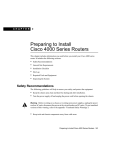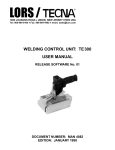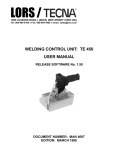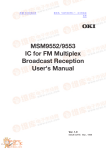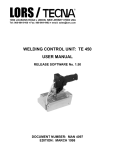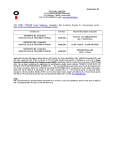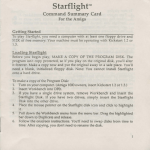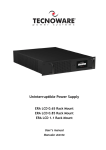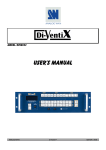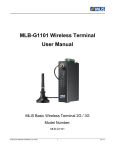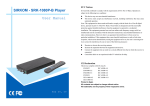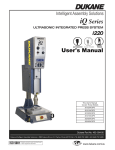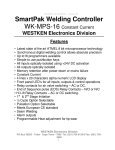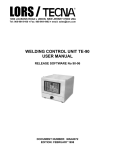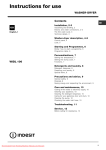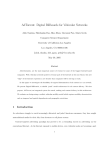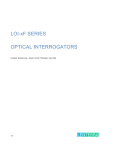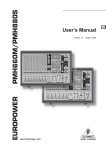Download Welding Control Unit TE-500
Transcript
LORS / j 1090 LOUSONS ROAD ♦ UNION, NEW JERSEY 07083 USA Tel: 908-964-9100 ♦ Fax: 908-964-4492 ♦ email: [email protected] WELDING CONTROL UNIT: TE 500 USER MANUAL RELEASE SOFTWARE No. 2.31 DOCUMENT NUMBER: MAN 4117 EDITION: JUNE 2003 This page is intentionally left blank. 2 / 52 TABLE OF CONTENTS TOPICS PAGE TE500 WELDING CONTROL UNIT 5 MAIN FEATURES 5 CONTROL UNIT SWITCH-ON 6 CONTROL UNIT PROGRAMMING 7 DESCRIPTION OF THE PARAMETERS 9 CONFIGURATION MENU 13 STEPPER MENU 15 CURRENT STEPPER OPERATING MODE 16 INSTALLATION MENU 21 PROGRAM COPY MENU 23 PROGRAM SEQUENCE MENU 24 PROGRAM SEQUENCE EXAMPLE 26 CHECK INPUT MENU 28 PANEL LEDs 29 COMMANDS ON THE PANEL 30 SELF-CALIBRATION PROCEDURE 31 SELECTION OF THE WORK PROGRAM 32 WORK MODES 33 CONSTANT CURRENT OPERATING MODE 34 DESCRIPTION OF THE WORK CYCLE 35 MEASUREMENT OF THE WELDING CURRENT AND THE CONDUCTION ANGLE 36 WELDING ANALYSIS 37 WELDING CURRENT AND CONDUCTION ANGLE LIMITS 38 COMPENSATION OF THE SECONDARY CURRENT 39 WELDING SPOTS COUNTER FUNCTION 39 SERIAL INTERFACE RS-232 ITEM 50214 (Option) 40 SERIAL INTERFACE RS-485 ITEM 50209 (Option) 42 INTERFACE FOR PROPORTIONAL VALVE ITEM 50220 (Option) 43 INTERFACING WITH AUTOMATIC SYSTEMS 44 DOUBLE STROKE FUNCTION 45 DESCRIPTION OF SIGNALS ON TERMINAL BOARD 46 MESSAGES LIST 48 FIRST INSERTION DELAY ADJUSTMENT 51 3 / 52 This page is intentionally left blank. 4 / 52 WELDING CONTROL UNIT TE 500 The TE 500 is a microprocessor-based welding control unit for resistance welders. The task of the welding control unit is to manage the welder components, in particular the controlled diodes that carry out the welding current control. It is possible to store up to 63 different welding programs, 31 of which are recalled directly from an external device. Each program comprises 18 programmable parameters that describe the work cycle. In addition to the plain 4-stage welding cycle, the control unit allows the running of welding processes with pre-welding current, post-welding current, slope and pulses. 2 1 2 3 4 MADE IN ITALY MAIN TECHNICAL DATA • • • • • • • • • • • • • • • • • • • • • Simplified programming via 6 keys and a backlit alphanumeric LCD. Synchronous control with controlled diodes, phase control current adjustment. Storage of 63 welding programs, 31 recallable from the outside. 26 programmable parameters for each program. Slope, pulses, pre-weld, post-weld functions and adjustment of the welding times in half-periods. Display of the RMS welding current measurement in kA and relative angle of conduction. Dual operating mode: standard and constant current. Welding current or angle of conduction limits. Double stroke function. Stepper function to compensate the electrodes wear with programmable curve. Counter for the performed welding spots. Compensation function of the secondary current for welding oxidized sheets and rods. Single and automatic cycle. WELD and NO-WELD function. Adjustment of first insertion delay. Control of 4 solenoid valves 24 Vdc max. 5 W with self-protected output. Auto-regulation at mains frequency 50/60 Hz. Serial data transmission by means of opto-isolated RS232 or RS485 ports. Output for optional proportional solenoid valve. Key for selecting foot control or two-hand control. Selectable languages: Italian, English, French, German and Spanish. Possibility of upgrading control unit Firmware via appropriate software. 5 / 52 CONTROL UNIT SWITCH-ON As soon as the welding control unit is turned on, the display shows the primary mains frequency and the software version of the program. SUPPLY FREQUENCY 50 Hz. TECNA TE500 2.31 WELD CONTROL UNIT After a few seconds, the TE500 is set to a waiting condition until the Restart key is pressed. This key enables the control unit’s commands and outputs. 009 PUSH KEY[//] RESTART TO CONTINUE It must be pressed every time the control unit is powered. When the key is pressed all the devices connected to the VAUX are powered, such as for example, any double stroke valves. k Before pressing the key it is important to check that it will not cause injury/damage to people or equipment. Before starting any welding operations, first program the welding data and set some general operating parameters of the welder. 6 / 52 CONTROL UNIT PROGRAMMING To begin the programming operations, turn the key in the PROG position and be aware of some of the fundamental features of the control unit. TE500 VER. 2.31 > PROGRAM DATA SETUP MENU STEPPER MENU The programming parameters of the control unit are divided into different menus as shown in the drawing above: _ PROGRAMMING _ CONFIGURATION _ STEPPER _ INSTALLATION _ PROGRAM COPYING _ INPUT CHECK _ PROGRAM SEQUENCES Arrow ">" on the left-hand side of the display indicates the cursor’s position. Use keys d and f to move the cursor up and down whereas keys h and g are used for entering and exiting from the menu selected by the cursor. Use keys a and s to set the value of the parameter indicated by the cursor. PROGRAMMING MENU The "Programming" menu contains all the parameters associated with the welding cycle, the times and the currents by means of which to carry out the welding process. PROGRAM DATA > PROGRAM NUMBER WORK MODE CONTROL MODE 01 IK CUR The first choice to make is the number of the program to be used. Choose among the 63 storable programs using the a and s keys. Then proceed with the next parameters moving with the d and f keys, adjusting the desired value always using the a and s keys. As such all the parameters will be set to the desired value for carrying out the welding process. Keep in mind that there is no need to confirm the set data item that is stored automatically after the adjustment. Parameters can have several values, according to the type of parameter. The minimum and maximum limits of each parameter are shown in the following table. 7 / 52 WORK PROGRAM PARAMETERS TABLE PARAMETER DESCRIPTION WORK MODE WORK MODE IK - PW%-FIX CONTROL MODE CONTROL MODE NO - CURR - DEG SQUEEZE 1 1s1 SQUEEZE TIME 01 - 99 cycles 2 SQUEEZE SQUEEZE TIME 00 - 99 cycles 3 PRESSURE WELDING PRESSURE 00 - 99 cycles 4 FORGE DELAY FORGING TIME 00 - 99 cycles 5 PRE-WELD PRE-WELD TIME 00.0 - 99.5 cycles 6 PRE-POWER PRE-WELD CURRENT 05 - 99% 7 COLD I COLD 1 TIME 00 - 50 cycles 8 SLOPE UP SLOPE UP TIME 00 - 25 cycles 9 WELD 1 WELDING TIME 00.5 - 99.5 cycles 10 POWER 1 CURRENT 1 WELDING CURRENT 5 - 99% 1.0 - 90.0 kA 11 COLD 2 COLD 2 TIME 01 - 50 cycles 12 N. IMPULSE NUMBER OF IMPULSES 00 - 09 13 SLOPE DOWN SLOPE DOWN TIME 00 - 25 cycles 14 COLD 3 COLD 3 TIME 00 - 50 cycles 15 POST-WELD POST-WELD TIME 00.0 - 99.5 cycles 16 POST-POWER POST-WELD CURRENT 05 - 99% 17 HOLD TIME HOLD TIME 01 - 99 cycles 18 OFF TIME DWELL TIME 00 - 99 cycles 1 VALUE RANGE If CONTROL MODE is activated it will be possible to have additional parameters, namely: 19 CURR MIN MIN LIMIT IN CURRENT 1.0 - 90.0 kA 20 CURR MAX. MAX. LIMIT IN CURRENT 1.0 - 90.0 kA if the CONTROL MODE parameter is set to CURR, otherwise 21 ANGLE MIN MIN LIMIT IN DEGREES 001° - 180° 22 ANGLE MAX. MAX. LIMIT IN DEGREES 001° - 180° if the parameter is set to DEG. There are few special conditions: • If OFF TIME is set to (0), the welding control unit will work in single cycle. • If OFF TIME is set to (99), the welding control unit will carry out the min. current compensation with a value lower than 2.0 kA (see paragraph "COMPENSATION OF THE SECONDARY CURRENT") • By setting the PRE-WELD parameter to zero, the pre-weld is not carried out. • By setting the POST-WELD parameter to zero, the post-weld is not carried out. 8 / 52 DESCRIPTION OF THE PARAMETERS All the following parameters that indicate times are expressed in periods, also called mains cycles. The mains frequency defines the duration of a period. Mains frequency of 50 Hz 1 period = 20 ms Mains frequency of 60 Hz 1 period = 16.6 ms WORK MODE The WORK MODE parameter defines the mode for adjusting the welding current of the program: either power percent (PW%), constant current (IK) or fixed (FIX). Welding time WELD 1 is carried out according to the adjustment mode set in this parameter. PRE-WELD and POST-WELD times are always run with the power percent or fixed adjustment. CONTROL MODE The CONTROL MODE parameter permits to select the control mode of the desired welding current. NO CUR DEG No control is performed on the supplied welding current. TE500 permits to set the welding current min. and max. limits. TE500 permits to set the min. and max. limits of the welding current conduction angle. For further information, please read the relevant paragraph. SQUEEZE 1 The 1st SQUEEZE time or first squeeze determines the time needed by the electrode to move down. If a pneumatic circuit is present with low-pressure squeeze, such time is that which determines the duration of the squeeze at low pressure, i.e. the interval of time that elapses from the beginning of the head descent to the application of the welding force. The set value must be long enough to allow the electrodes to reach the workpiece to be welded. In a standard pneumatic circuit, such time is the interval from the beginning of the head descent to the beginning of the welding. The set value must be long enough to allow the electrodes to achieve the proper clamping force, before the welding begins. During the first squeeze time, it is possible to end the cycle if the start cycle signal is deactivated. SQUEEZE Optional The SQUEEZE time is a wait time like that of the 1st SQUEEZE. It is necessary for welding machines with low-pressure squeeze functions. In this case, such time determines the interval from the application of the welding force onto the electrodes (energizing of the SV2 valve) to the beginning of the welding. It should be long enough to allow the electrodes to achieve the proper clamping force before the welding begins. An inadequate adjustment of such time produces sparks among the electrodes and the sheet when the welding begins, causing quality inconsistencies. If the welding machine does not contemplate low-pressure squeeze, deactivate this parameter (see Installation Menu). Otherwise it will be added to the 1st squeeze time. If the start cycle signal is deactivated, during the squeeze time, the sequence is interrupted. 9 / 52 PRESSURE Optional This parameter, expressed in bar, expresses the welding pressure value. The set value must be such that it guarantees a proper clamping force during the welding cycle. An inadequate adjustment of such value produces sparks between electrodes and sheet when the welding begins. FORGE DELAY Optional The FORGE DELAY parameter is used exclusively with pneumatic circuits that contemplate the forging function. Such function permits to increase the electrode force during the welding cycle. The parameter describes the time that elapses from the beginning of the welding process to the application of the forging force onto the electrodes by means of solenoid valve SV3. If the value is set to zero the forging function is disabled, valve SV3 will be activated at the beginning of the squeezing phase. PRE-WELD The PRE-WELD parameter indicates the duration of a current flow that can be carried out before the welding process so as to pre-heat the workpiece to be welded. This parameter is expressed by three digits since it can be set with half-period precision. If this parameter is set to 0, the pre-weld will not be carried out. Pre-weld is carried out with a current adjustment equivalent to that indicated in the PREPOWER parameter (PRE-WELD CURRENT). PRE-POWER (PRE-WELD CURRENT) The value expressed in this parameter indicates the power used for carrying out the pre-weld. COLD 1 The COLD 1 parameter indicates the time that elapses from the pre-weld (PRE-WELD) to the weld (WELD 1). If the pre-weld is deactivated (that is, when PRE-WELD time = 0), this cooling time is not carried out. SLOPE UP The SLOPE UP parameter describes the time for attaining the programmed welding current value. The starting value of this slope always corresponds to the minimum current, whereas the final value corresponds to the current value set at parameter CURRENT 1 (WELDING CURRENT). The slope inclination is automatically calculated by the microprocessor according to the set values. The SLOPE UP time is added to the welding time (WELD 1). WELD 1 (WELDING TIME) The WELD 1 parameter indicates the welding current flow duration. It is carried out with the same power value set at parameter CURRENT 1 (WELDING CURRENT). When the pulse operating mode is activated, this parameter indicates the duration of each pulse. This parameter is expressed by three digits since it can be adjusted with half-period precision. 10 / 52 CURRENT 1 (WELDING CURRENT) The value indicated in CURRENT 1 shows the current adjustment used for carrying out the welding process. Depending on the adjustment mode selected by means of the WORK MODE parameter, this value indicates either the current percent adjustment (PW%, power percent adjustment), or the required welding current value expressed in kA (IK, constant current adjustment). N. IMPULSE (NUMBER OF IMPULSES) The N. IMPULSE parameter indicates the number of impulses used for carrying out the welding process. The duration of each impulse corresponds to the time set in parameter WELD 1 (WELDING TIME). COLD 2 (COLD 2 TIME) The COLD 2 parameter is used in the pulse operating mode; it indicates the time that elapses from a welding impulse to the next one. SLOPE DOWN The SLOPE DOWN parameter is a welding time that is added at the end of the welding process: it enables to decrease the welding current from the value set at CURRENT 1 down to the minimum value. The slope inclination is automatically calculated by the microprocessor according to the set values. The SLOPE DOWN time is always added to the welding time. COLD 3 (COLD 3 TIME) The COLD 3 parameter indicates the time that elapses from the welding process (WELD 1) to the postweld (POST-WELD). POST-WELD The POST-WELD parameter indicates the duration of a current flow that can be carried out after the welding time in order to enable a more gradual cooling of the welded workpiece. This parameter is expressed by three digits since it can be adjusted with half-period precision. If this parameter is set to 0 the post-weld is not carried out. The post-weld is carried out with the current adjustment set in the POST-POWER parameter. POST-POWER The value expressed in this parameter indicates the post-welding power. HOLD TIME The HOLD parameter indicates the time that elapses from the end of the welding process to the opening of the electrodes. It allows a quicker cooling of the welding spot and prevents the spot from being stimulated before being properly cooled. OFF TIME (DWELL TIME) The OFF TIME parameter indicates a welder wait time, namely the one that elapses from one welder cycle to the next one when the welder is working in automatic cycle. When this value is set to zero, the welder always works in single cycle; if it is set to another value, the welder will work in the automatic cycle. When the welder works in single cycle, the control unit carries out a single welding cycle each time it receives a start cycle signal. When the welder works in automatic cycle, the welder goes on executing welding cycles until the start cycle signal is released. By programming this parameter to 99 the welding current compensation function is activated (see the relevant paragraph). 11 / 52 CURR MIN / ANGLE MIN (MINIMUM CURRENT LIMIT OR CONDUCTION ANGLE) The meaning of this parameter depends on the control mode selected in the CONTROL MODE parameter. When the control unit is set to current control mode (CONTROL MODE=CUR), this parameter fixes a minimum current value. For each weld, the TE500 monitors that the welding current supplied by the welder is higher than the value set at this parameter; if it is lower, an error message will be displayed (see the relevant paragraph). When the control unit is set to degree control mode (CONTROL MODE=DEG), this parameter fixes a minimum conduction angle value. For each weld, the TE500 monitors that the maximum welding current conduction angle supplied by the welder is higher than the value set at this parameter; if it is lower, an error message will be displayed (see the relevant paragraph). If the CONTROL MODE parameter is set to NO (no control on the welding current), the parameter is not displayed during the programming phase. CURR MAX. / ANGLE MAX. (MAXIMUM CURRENT LIMIT OR CONDUCTION ANGLE) This parameter expresses different data according to the control mode selected at the CONTROL MODE parameter: When the control unit is set to current control mode (CONTROL MODE=CUR), this parameter fixes a maximum current value. For each weld, the TE500 monitors that the welding current supplied by the welder is lower than the value set in this parameter; if it is higher, an error message will be displayed (see the relevant paragraph). When the control unit is set to degree control mode (CONTROL MODE=DEG), this parameter fixes a maximum conduction angle value. For each weld, the TE500 monitors that the maximum welding current conduction angle supplied by the welder is lower than the value set in this parameter; if it is higher, an error message will be displayed (see the relevant angle). If the CONTROL MODE parameter is set to NO (no control on the welding current), the parameter is not displayed during the programming phase.é 12 / 52 CONFIGURATION MENU The "Configuration" menu contains those parameters that are used for enabling or disabling a function of the control unit. ---CONFIGURATION--> START CYCLE1 10 START CYCLE2 06 SPOTS PRINT OFF CONFIGURATION MENU PARAMETERS TABLE PARAMETER DESCRIPTION VALUE RANGE START1 PRG Start cycle 1 program 00 - 63 START2 PRG Start cycle 2 program 01 - 63 PRINTER SPOT Welding spots print ALL - GOOD - BAD STOP BAD SPOT Number of spots for out-of-limit stop 0-9 PROG SEQUENCE Program sequence activation ON - OFF AMMETER CAP. Ammeter capacity 40 - 90 kA CALIBRATION Self-calibration procedure ON - OFF LANGUAGE Language for describing parameters ITA-ENG-SPA-DEU-FRE START CYCLE 1 This parameter indicates the program number to be run when the cycle is activated from the start cycle 1 command. The value of the program also includes 0 which, if set, allows the control unit to work with the program that is active in the setting. START CYCLE 2 This parameter indicates the program number to be run when the cycle is activated from the start cycle 2 command. SPOTS PRINT With this parameter, if the serial port is setup for print (see "Installation" paragraph), the user can choose which welding spots to be printed. It is possible to print all spots or only the spots whose current value remains within the set limits or those with out-of-limits values. OUT-OF-LIMITS SPOTS STOPPING FUNCTION Parameter STOP SPOTS permits to program the control unit so that it stops when out-of-limits welding spots are performed. The set value indicates the number of consecutive "out-of-limits" welding spots after which the machine stops. The limit error occurs when a welding spot is carried out with values either higher or lower than the limits set in parameters CURR MIN and CURR MAX. To set the value use keys a and s ; the value can be set from 0 to 9. If the value is set to zero, this function is deactivated; in this case, the welder does not stop even in case of "out-of-limits" welding spots. PROGRAM SEQUENCE The sequence type operation is activated with this parameter. If this parameter is set to ON, the menu for setting the program sequences will appear in the list of the main menus. 13 / 52 AMMETER CAPACITY This parameter indicates the ammeter capacity of the control unit. Keep in mind that the capacity refers to simple harmonic currents and as such overflow conditions might occur even with effective current values lower than the nominal value of the carrying capacity and this depends on the sensitiveness of the connected transducer. CALIBRATION Set this parameter to ON for starting the self-calibration procedure. For further information refer to the relevant paragraph. LANGUAGE With this parameter the user programs the language in which the control unit should display both the parameters to be set and the error messages. 14 / 52 STEPPER MENU The "Stepper" menu contains parameters associated with the current stepper operations. --- STEPPER --> NUM. INCREMENTS 01 SPOTS 1 4000 INCREMENT 1 12% STEPPER MENU PARAMETERS TABLE PARAMETER DESCRIPTION VALUE RANGE TOTAL STEPS Number of incremental steps 01 - 07 SPOTS 1 Spots step 1 0 - 10000 INCREMENT-1 % Percent increment step 1 0 - 50 SPOTS 2 Spots step 2 0 - 5000 INCREMENT 2 % Percent increment step 2 0 - 50 SPOTS 3 Spots step 3 0 - 5000 INCREMENT 3 % Percent increment step 3 0 - 50 SPOTS 4 Spots step 4 0 - 5000 INCREMENT 4 % Percent increment step 4 0 - 50 SPOTS 5 Spots step 5 0 - 5000 INCREMENT 5 % Percent increment step 5 0 - 50 SPOTS 6 Spots step 6 0 - 5000 INCREMENT 6 % Percent increment step 6 0 - 50 SPOTS 7 Spots step 7 0 - 5000 INCREMENT 7 % Percent increment step 7 0 - 50 NUM. OF INCREMENTS This parameter indicates how many segments are to be created for implementing the stepper curve. Only the parameters that describe the desired function will be displayed in relation to the set value. SPOTS 1,2,3,... Each of these parameters indicates the number of spots of which the associated segment is composed. INCREMENT 1,2,3,... These parameters indicate the current stepper percent to be attained upon the completing of the spots set in the associated segment. 15 / 52 CURRENT STEPPER FUNCTION The stepper function enables to compensate the wear of the electrodes that affects the quality of the welding spots. When the electrode diameter is enlarged, the contact section area between the electrode and the workpiece to be welded increases and, as a consequence, the welding current density (Ampere/mm2) decreases. If the current is maintained at a fixed value throughout the whole electrode life, it will be noticed that the quality of the last spots is poorer than the first ones. The stepper function is used for overcoming this problem. It gradually increases the current adjustment during the welding process when the diameter of the electrodes increases: this enables to maintain a constant current density. This function is suitable especially when using the control unit in constant current mode. Nevertheless, it also works when the control unit operates in percent adjustment mode, but it is not active in FIX mode. An increment curve is programmed to describe the pattern of the current during the electrodes' life. This curve is described by one or more segments for each of which the number of welding spots and the associated current increment in percent are programmed. After it has been set, the current increment is applied to all the welding programs used. The current or conduction angle limits, if used, increment by the same percent. The same holds true for the pre-weld and post-weld current adjustments. If the set welding (or power) current values are changed during the process, the control unit takes them into consideration and re-calculates the welding conditions. If modifications are made to the programmed stepper curve, the control unit clears the counter and therefore the starting diameter of the electrodes must be reset. SIMPLIFIED USE OF THE STEPPER FUNCTION (LINEAR INCREMENT) The stepper function can be used in a simplified manner by programming a simple percent increment for a specific number of welding spots that are to be carried out with the same electrodes. The user must know the service life of the electrodes in order to adjust these parameters. To do this run some welding tests with new electrodes before they are replaced. Under these two conditions the currents, required for carrying out the welding spots of the required quality, are assessed. The change in percent is calculated and then it is set in the control unit. The parameters that allow the carrying out of the stepper function are entered in the "Stepper" menu. The instructions for programming these parameters are outlined in the relevant paragraph. For the "simplified" use of the stepper function, always set parameter STEPS INCREM to 1 (since the segment to be programmed is only one). Enter the number of welding spots to be carried out in parameter SPOTS 1, i.e. the foreseen life span of the electrodes. Enter the percent increment to be achieved in parameter INCREMENT 1. 16 / 52 Example: After having run the welding tests, the result was that the usable life of the electrodes = 2000 welding spots. Another fact that ensued was that the required current for new electrodes = 15 kA, whereas after 2000 welding spots the diameter increase of the electrodes requires a current of 19 kA. Therefore calculate the change in percent as follows: Change % = endcurrent − initialcur rent 19 − 15 × 100 = × 100 = 26% initialcur rent 15 Consequently the following parameters are set in the "Stepper" menu: PARAMETER DESCRIPTION VALUE STEPS INCREM Number of segments for stepper function SPOTS 1 First segment spots number 2000 INCREMENT1 First segment increment percent 26% 1 The welding program should be adjusted for carrying out the first welding spot followed by the adjustment that permits to obtain the required current with the starting electrode diameter: 15 kA. Now the welding process can begin. Current will vary conforming to the set increment rule. The graph below shows its pattern. CURRENT INCREMENT DURING PRODUCTION 20 WELDING CURRENT (kA INITIAL CURRENT = 15 kA END CURRENT = 19 kA INCREMENT PERCENT = 26 % NUMBER OF WELDING SPOTS = 2000 18 16 14 12 10 8 6 4 2 0 0 500 1000 1500 NUMBER OF WELDING SPOTS 2000 Upon having completed all 2000 welding spots the TE500 stops the production cycle and displays the following message: 22 ------STOP-----MAX. N. of SPOTS At this point the operator replaces the electrodes (or resets their original diameter) and clears the spots counter to clear stepper calculations. The TE500 resets the initial work parameters and begins a new increment phase. 17 / 52 COMPLETE USE (NON-LINEAR INCREMENT CURVE) In the aforesaid work method, a linear welding current increment is used during the whole life span of the electrodes. In actual fact the increase of the contact section of the electrode on the sheet is not linear but has a pattern that is similar to the one shown in the graph below. CURRENT IDEL PATTERN REAL PATTERN WITH LINEAR INCREMENT NUMBER OF WELDING SPOTS As such the use of the linear increment is an approximation which nonetheless permits to achieve good results in most applications. However when the user wishes to achieve utmost constancy during work conditions, a non-linear increment curve can be set that is described by defining a certain number of segments. This type of adjustment requires an adequate knowledge on how electrodes wear and on the parameters required during their life. Consequently many welding spot tests are necessary for assessing the work conditions in different moments of the electrodes' life. CURRENT IDEAL PATTERN REAL PATTERN WITH SET INCREMENT CURVE NUMBER OF WELDING SPOTS The increment curve is set by assessing a certain number of linear segments. The number of welding spots and the desired increment are assessed for each segment. The STEPS INCREM parameter determines the number of segments to be inserted in the increment curve. Enter the number of welding spots that make up the segment in the “SPOTS n” parameters. Enter the corresponding percent increment to be achieved in the “INCREMENT n” parameter. The programming procedure is outlined in the "Stepper" menu paragraph. 18 / 52 Example: After a number of welding tests, the ensuing life of the electrodes resulted to be 4000 welding spots and the following current values are required during the different moments of the electrodes' life. SPOTS PERFORMED REQUIRED CURRENT 0 (initial electrode diameter) 15 kA 700 17.8 kA 1800 19.5 kA 3000 20.2 kA 4000 (final electrode diameter) 20.7 kA Therefore calculate the duration (in number of welding spots) and the percent increment of each segment. Keep in mind that the percent increment must always be calculated in relation to the beginning of the segment being examined. Duration of segment 1 = 700 - 0 = 700 spots Duration of segment 2 = 1800 - 700 = 1100 spots Duration of segment 3 = 3000 - 1800 = 1200 spots Duration of segment 4 = 4000 - 3000 = 1000 spots Change % segment 1 = endcurrent − initialcur rent 17.8 − 15 × 100 = × 100 = 19% initialcur rent 15 Change % segment 2 = endcurrent − initialcur rent 19.5 − 17.8 × 100 = × 100 = 10% initialcur rent 17.8 Change % segment 3 = endcurrent − initialcur rent 20.2 − 19.5 × 100 = × 100 = 4% initialcur rent 19.5 Change % segment 4 = enecurrent − initialcur rent 20.8 − 20.2 × 100 = × 100 = 3% initialcur rent 20.2 The following parameters are consequently set in the "Stepper" menu: PARAMETER DESCRIPTION VALUE TOTAL STEPS Number of segments per stepper function SPOTS 1 Number of spots of the first segment 700 INCREMENT1 Increment percent of first segment 19% SPOTS 2 Number of spots of the second segment 1100 INCREMENT2 Increment percent of second segment 10% SPOTS 3 Number of spots of the third segment 1200 INCREMENT3 Increment percent of third segment SPOTS 4 Number of spots of the fourth segment INCREMENT4 Increment percent of fourth segment 19 / 52 4 4% 1000 3% The welding program should be adjusted for carrying out the first welding spot followed by the adjustment that allows the achieving of the required current with the starting diameter of the electrodes: 15 kA. Now the welding process can begin. Current will change according to the programmed increment rule. The graph below shows its pattern. 22 20.7 kA 21 20.2 kA 19.5 kA SEGMENT 4 19 SEGMENT 3 17.8 kA 18 SEGMENT 2 17 16 15 1800 14 3000 SEGMENT 1 700 CURRENT (kA) 20 13 0 1000 2000 3000 NUMBER OF WELDING SPOTS 20 / 52 4000 INSTALLATION MENU The installation menu contains the parameters that determine the complexity and typology of the welder at which the control unit is working. Therefore, due to their importance, the access to this menu is protected by a code. 035 ENTER ACCESS CODE * * * * If the user is not authorized and consequently does not know the access code, the following message is displayed: 036 ACCESS CODE ERROR ACCESS DENIED !! The parameters can be edited only after having typed in the access code. k Keep in mind that only skilled personnel are permitted to edit the following parameters to prevent damage to people or equipment. PARAMETER DESCRIPTION st VALUE RANGE FIRST INSERT. 1 Insertion delay 01 - 99 SERIAL COM. Serial communication PRT/232 - NET/485 - NONE NETWORK ADDRESS Network address 01 - 32 COIL RATIO Rogowski ratio X1 - X5 - X10 LOCK/END OUT Output function END - LOCK FUNCTION REC. Recall function 5 RIC5 - ODD - EVEN LOW FORCE SQ. Low force squeeze ON - OFF FORGE Forging ON - OFF PROPORT. VALVE Proportional valve ON - OFF PRESSURE RATIO Pressure transducer for proportional 0.1 - 2.0 FIRST INSERTION DELAY FUNCTION The FIRST INSERTION parameter shows the first insertion delay. This function permits to optimize the balance of the mains consumption of the welder. After having selected this parameter, the value can be adjusted from 1 to 99 with keys a and s . For more information refer to the specific chapter. SERIAL COMM. The user may choose whether to activate the serial data transmission port and how it is to be used, connect a printer (PRT/232) or connect the control unit to a data supervision network (NET/485), or not use this option (NONE). NETWORK ADDRESS This parameter indicates the identifying address of the control unit when connected in the network, activating the aforesaid option. 21 / 52 COIL RATIO This parameter shows the sensitivity of the current transducer installed on the welder. OPTIONS SIGNAL RATIO AMMETER CAPACITY X1 150 mV / kA 40 - 90 kA X5 750 mV / kA 8 - 18 kA X10 1.5 V / kA 4 - 9 kA LOCK/END OUT This parameter indicates, interlock (LOCK) or cycle end (END), the activation time of the corresponding output. RECALL 5 FUNCTION This parameter indicates the function associated to the Recall 5 input. _ Input for the direct recalling of the work program up to 31 (REC 5). _ EVEN parity test input for the other recalls. _ ODD parity test input for the other recalls. LOW FORCE SQUEEZE This parameter is activated for welders that envisage the low-pressure squeeze function. Its enabling adds the Squeeze parameter to the welding program. FORGE FUNCTION This parameter is used for enabling the forging for pneumatic circuit welders that envisage this function. Its enabling adds the Forge Delay parameter to the work program. PROPORTIONAL VALVE This parameter is used for welders that envisage the use of a proportional valve and the parameter that is activated in the program is the Pressure parameter. PRESSURE TRANSDUCER With this parameter it is possible to select, if the above parameter is activated, the most suitable BAR/ VOLT ratio for the type of solenoid valve the user intends using. 22 / 52 PROGRAM COPY MENU The "Program copy" menu is used for copying the values of the parameters of a program to other programs without having to set one parameter at a time. -- PROGRAMS COPY -> SOURCE PROGRAM 03 FROM PROGRAM 06 TO PROGRAM 10 PROGRAM COPY MENU PARAMETERS TABLE PARAMETER DESCRIPTION VALUE RANGE SOURCE PROGRAM Source program 01 - 63 FROM PROGRAM Program start copy/target 01 - 63 TO PROGRAM Copy end program 00 - 63 SOURCE PROGRAM This program indicates the number of the program to be copied to other programs. The value of this parameter may vary from 01 to 63. COPY FROM PROGRAM This program indicates the first program into which the source program is copied in the case of a multiprogram copying operation. If it concerns an individual copying, it represents the target program to which the source program is to be copied. The value of this parameter may vary from 01 to 63. TO PROGRAM This program indicates the last program into which to copy the source program. The value of this parameter may vary from 00 to 63. Programmed value 00 indicates that the source program will be copied to the target program only. To copy programs access the copy menu from the main menu using key g , set the desired values in the aforesaid parameters and then press key h . Now the confirmation message of the copying action is displayed: COPY PROGRAM <03> FROM <06> TO <10> ? PRESS KEY[+]=OK ❙❙❙❙❙❙❙❙❙❙❙ Press key a to copy, conforming to the parameters displayed in the video page shown above. The operation is completed when the last line of the display is filled and the control unit shows the main programming video page. If any other key is pressed or if you wait a few seconds, the operation will not be carried out and the main programming video page is returned to. 23 / 52 PROGRAM SEQUENCE MENU This menu includes the parameters required for activating the program sequence operations. In this work mode the weld control unit commands the welder to perform a series of spots, deciding automatically the work program for each spot and the spots order without having to make an external selection of the program. This menu is not always active in the main programming menu. It is activated by setting the parameter of the Setup to ON. PROG SEQUENCE Program sequence activation ON When this menu is activated it can be accessed with key g and the parameters shown in the figure can be set. - PROGRAM SEQUENCES> NUM. STEPS 02 PROG. STEP 1 03 WELD STEP 1 07 PROGRAM SEQUENCE MENU PARAMETERS TABLE PARAMETER DESCRIPTION VALUE RANGE NUMBER SEQUENCES Number of sequences 01 - 05 STEP 1 PRG. Program of step 1 01 - 63 STEP 1 WELDS Number of welds with step 2 00 - 20 STEP 2 PRG. Program of step 2 01 - 63 STEP 2 WELDS Number of welds with step 1 00 - 20 STEP 3 PRG. Program of step 3 01 - 63 STEP 3 WELDS Number of welds with step 3 00 - 20 STEP 4 PRG. Program of step 4 01 - 63 STEP 4 WELDS Number of welds with step 4 00 - 20 STEP 5 PRG. Program of step 5 01 - 63 STEP 5 WELDS Number of welds with step 5 00 - 20 N. STEPS The value of this parameter indicates the number of steps, i.e. the number of spot sequences with different work programs. STEP PROG. 1,2,3,... This program indicates the program number that the welder must carry out and is matched to the associated step number. WELDS STEP 1,2,3,... The value of this parameter indicates the number of welds to be carried out with the program matched to the same step. After having activated this mode and having set the parameters of the "Program sequences" menu as described above, the welding spots can be started. With the key in RUN position, the display shows the sequence data as shown in the figure below. 24 / 52 WELD 008 OF 013 STEP 03 OF 04 PROG. 03 RMS 10.45 NEXT WELD 009 Information on the display indicates the following: $ Line 1. The succeeding number of the last weld performed and the total number of welds of which this sequence is composed. $ Line 2. The number of the step with which the last weld was performed and the total number of steps. $ Line 3. The program number and the RMS current value of the last weld. $ Line 4. The progressive number of the next weld. 25 / 52 PROGRAM SEQUENCE MENU Let's take for example the sequence operation after having set the following values in the parameters. PARAMETER VALUE NUMBER SEQUENCE 04 STEP 1 PRG. 03 STEP 1 WELDS 04 STEP 2 PRG. 07 STEP 2 WELDS 02 STEP 3 PRG. 11 STEP 3 WELDS 06 STEP 4 PRG. 04 STEP 4 WELDS 01 For each start cycle signal a spot is carried out with the weld program associated with the current step. In this specific case, as shown in the chart below, the following welds are performed in sequence: $ $ $ $ 4 welds with program 03 2 welds with program 07 6 welds with program 11 1 weld with program 04 WELD 1 2 3 4 5 6 7 8 9 10 11 12 13 STEP 1 1 1 1 2 2 3 3 3 3 3 3 4 PROG 03 03 03 03 07 07 11 11 11 11 11 11 04 Usually this type of operation is applied to one manual welder where the operator always performs weld spots in the same order but with different work parameters. By means of this system the operator does not need to change the program manually which would cause his/her attention to be distracted from the workpiece to be welded or does not have to change pedal or other start cycle device. However the operator must pay utmost attention during the process not to perform fewer spots than those programmed, overlapping spots or not in the same order. 26 / 52 In any case if a sequence process error is made, it is possible to repeat the last weld or another weld, or continue by avoiding some spots. Always with the key in RUN position, use keys a to increase the welds counter to the next spot or to the desired spot. Use key s to go back one or more positions of the spots to be carried out. Display data Display data after key WELD 006 OF 013 STEP 02 OF 04 PROG. 07 RMS 06.15 NEXT WELD 007 WELD 007 OF 013 STEP 03 OF 04 PROG. 11 RMS 06.15 NEXT WELD 008 WELD 013 OF 013 STEP 04 OF 04 PROG. 04 RMS 04.31 NEXT WELD 001 WELD 012 OF 013 STEP 03 OF 04 PROG. 11 RMS 04.31 NEXT WELD 013 27 / 52 CHECK INPUT MENU This menu displays the status of the welding control unit inputs. It is activated with the key in PROG position and is used for checking the efficiency and proper operation of the external devices, connected to the control unit, required for using the welder. -- CHECK INPUT -> START N.O. OFF START N.O. ON START2 N.O. OFF All the inputs available at the connectors of the control unit are included in the list that is scrolled with keys d and f . The status of the inputs is shown as active (Input closed with COM1) with wording ON; not active with wording OFF. 28 / 52 PANEL LEDs The turning on of this LED indicates that the welder control unit is powered. If this LED is switched on it indicates that start cycle 1 command is activated. 2 If this LED is switched on it indicates that start cycle 2 command is activated. The turning on of this LED indicates that the pressure-only stopping command is activated. The turning on of this LED indicates that the control unit is producing the command impulses for the SCR. 1 It indicates that the solenoid valve 1, which carries out the main cycle, is activated. 2 It indicates that the solenoid valve, which controls back pressure, is activated. 3 It indicates that the solenoid valve, which carries out the pressure or forging cycle, is activated. 4 It indicates that the solenoid valve, which controls the double stroke, is activated. 29 / 52 COMMANDS ON THE PANEL Left direction key used for exiting from the programming menu. Right direction key used for accessing the programming menu. Up direction key used for moving the cursor into the upper parameter. Down direction key used for moving the cursor into the lower parameter. This key is used for increasing the value of a numeric parameter, or for changing the status of a parameter. This key is used for decreasing the value of a numeric parameter, or for changing the status of a parameter. RESTART key. It enables the commands and the control unit's outputs. It must be pressed every time the control unit is powered. When this key is pressed, all the devices connected to VAUX are powered such as for example any double stroke valves. Before pressing the key it is important to check that it will not cause injury/damage to people or equipment. Key for selecting the start cycle device: PEDAL or TWO-HAND CONTROL. When the nearby LED is switched off, the start cycle command is carried out by the PEDAL whereas if the LED is switched on, the command is carried out by two-hand push buttons (TWO-HANDS CONTROL). In order to work properly, the two push buttons must be pressed at the same time or in sequence within a maximum time of 0.5 seconds conforming to the accident prevention regulations. WELD-NO WELD Key. In WELD position (LED switched on) the control unit runs the programmed welding cycle. In NO-WELD position (LED switched off), the control unit runs the programmed cycle without welding current circulation yet keeping all the time parameters unchanged. CLEAR Key. It is used to clear the error conditions and for zeroing the welds counter and during programming activities for zeroing the parameters. PROG-RUN Key selector. In PROG position (key turned to the 4-button position) it enables the keyboard and allows the running of all the foreseen programming operations. In RUN position it enables the spot welder commands and allows the running of the work program only. 30 / 52 SELF-CALIBRATION PROCEDURE This procedure allows the control unit to read the welder's characteristics and also to optimize the current adjustment. The values measured with this procedure are used for the correct working of the welding current adjustment. We recommend to repeat this procedure if the welder arms are replaced with others having different dimensions, especially when working in constant current mode. This permits to obtain the best adjustment precision. k Before carrying out this procedure, both the control unit and the welder must be set to standard work conditions. In this phase, a very short weld is carried out with high welding currents; therefore the electrodes must have a proper diameter, and the welder must be adjusted to an adequate electrode force. A pressure of at least 4 bar is recommended. The self-calibration welding procedure must be carried out in short-circuit. The following operations are to be carried out in the following order: 1. 2. 3. 4. 5. Enter the setup menu, by turning the key to PROG position and selecting the SETUP item Select the CALIBRATION parameter by means of keys d and f ; set it to ON by means of keys a and s . Turn the key to RUN position to end the programming phase. At this point the display shows the standard work data associated with the last spot performed. Ensure that the WELD/NO WELD function is set to WELD (LED must be on). Activate the start cycle device. The control unit displays the following message and carries out one welding spot, which lasts for a few periods, with different current adjustments. CALIBRATION IN PROGRESS When this procedure is completed, the control unit displays the maximum current value supplied and the machine's cosn value. CALIBRATION OK Fi=34° 17kA If error messages are displayed instead of the aforesaid message, proceed as follows: $ $ Clear the error by pressing any key. Eliminate the cause that triggered the error (see specific paragraph). k Activate the start cycle device again for repeating the self-calibration welding procedure. 31 / 52 SELECTION OF THE WORK PROGRAM The table below shows which inputs are to be activated to recall the work program directly. The selection is made by means of five inputs, appropriately activated according to the combinations shown below. PROG. N. REC1 1 • 2 3 REC2 • • 11 • • • • • • • • • • • • 12 13 • 14 15 • • 10 • • • • • • • • • • • • • • • • • • • • • • • • • • • • • • • • • 24 25 • 26 27 • 31 •= • • • • • • • • • 30 • • • 28 29 • • • 22 23 • • 20 21 • • 18 19 • • 16 17 REC5 ODD • • • • REC5 EVEN • 8 9 REC5 • 6 7 REC4 • 4 5 REC3 • • • • • • • • • • • • • • input active The programs that can be selected are 31, when using input REC5 as additional recall input, or 15 if using input REC5 as parity check. The use of input REC5 as parity check is activated in the "Installation" Menu (see specific paragraph) in which the type of parity is also selected: Even or Odd. The parity check consists in checking that the number of activated inputs, for recalling a program, is even or odd. Example: Recall of Prog. N. 06 with even parity check. To recall program 6 you must activate two inputs, REC2 and REC3, but since parity is odd you must also activate input REC5 to obtain an odd number of active inputs. To properly recall the welding programs, either activate the direct recall inputs before the start cycle signal or simultaneously. 32 / 52 WORK MODES The TE500 weld control unit permits to perform welds with different welding current supply and check methods. The table below shows the different modes, the operations required for activating them and the compatible functions. FIX PW% IK Self-calibration procedure x z z Rogowski ring sensor x x z Stepper function NO YES YES Program sequence function YES YES YES CUR control mode YES YES YES DEG control mode YES YES YES Current compensation YES YES NO Welding analysis YES YES YES Proportional valve YES YES YES Rogowski ratio All Only the one with which the Selfcalibration is performed Only the one with which the Selfcalibration is performed Automatic mains compensation NO NO YES First insertion delay z z z Ammeter capacity All Only the one recommended in Selfcalibration Only the one recommended in Selfcalibration x = not compulsory z = compulsory 33 / 52 CONSTANT CURRENT OPERATING MODE TE500 allows the user to adjust the welding current in two different operating modes: the standard percent adjustment, and the constant current adjustment. When the control unit works in constant current, it is possible to set the welding current value directly. During the welding process the control unit measures, for each half-period, the true welding current RMS value and, based on a correcting mathematical algorithm, keeps the set current. In addition to simplifying the programming operations, this operating mode also permits to keep the desired welding current even if some factors change such as: mains voltage, welding circuit dimensions and impedance, condition of the welding tools, surface conditions of the materials being processed. CONSTANT CURRENT BEHAVIOR READINGS Welding current changes (I) according to the mains voltage (V) variation under standard operating mode Welding current changes (I) according to the mains voltage (V) variation under constant current operating mode The selection of the current adjustment mode is independent for each welding program and is set by means of the WORKING MODE parameter. $ By setting the PW% value the welding current adjustment is carried out in percent values. Please, notice that the set value stands for the real percent value of the welder maximum current. $ By setting the IK value the program in progress carries out the adjustment mode in constant current. TE500 monitors the welder characteristics by means of the self-calibration procedure. The values measured during this operation are used for the correct functioning of the working mode in constant current. In order to get a better adjustment precision, we recommend to repeat this procedure in case the arms are replaced with other having different dimensions. This procedure is described in the relevant paragraph. When operating in constant current mode and if during the welding process for any reasons, there is no current circulation, the control unit does not carry out the adjustment: it blocks the welding process and displays the following error message: NO SECONDARY CURRENT SIGNAL 34 / 52 DESCRIPTION OF THE WORK CYCLE The TE500 work cycle is set by the user by adjusting the programming parameters. These parameters indicate the operating times and the current adjustments characterizing the work cycle when carried out consecutively. The following chart shows the sequence in which the programmed functions are carried out. The aforesaid numbers refer to the programming parameters described in the "Programming" Menu paragraph. k For safety reasons, the microprocessor does not start the welding cycle if the start cycle device is activated when switching on the welder; release it and restart it. Any microinterruptions or excessive voltage drops will stop the control unit and do not alter the operation; to reset the operation, turn the machine off and then turn it on again. 35 / 52 READING OF THE WELDING CURRENT AND THE CONDUCTION ANGLE After every welding operation, the display shows the following information: $ $ $ $ $ The welding program used. The number of the welding spots carried out as of the last counter reset. The current conduction angle of the last welding spot. The set welding time. The value of the current of the last welding spot. PROG. 01 SPOT 12340 WELD CYCLE 01.0 CURRENT RMS 43.26 CONDUCTION DEG 142° The value of the current, which the control unit measures and which is displayed, stands for the average of the RMS values measured for every welding time half-period. The displayed value always refers to the main adjustment i.e. to that of the WELD 1 parameter. For pulse welding spots the value of the current will always be the average value of all the impulses. The control unit also measures the welding current conduction angle. The conduction angle stands for the time in which the current was carried during the half-period. The displayed value stands for the average of the values measured for each welding time half-period. The displayed value always refers to the main adjustment i.e. to that of the WELD 1 parameter. The conduction angle of the current that circulated during the slope times is never measured. For pulse welding spots the value of the angle is related to the last impulse the maximum value of which can be 180 degrees. Example of currents with different conduction angles: If a test welding stop is performed in "NO WELD" mode, the current and conduction angle values displayed will be zero. 36 / 52 WELDING ANALYSIS The welding pattern can be analyzed exhaustively by means of the welding check. It is possible to view in detail the current values and the conduction degrees, read at each half-cycle of the main WELD1, the values of any pre-welds and post-welds, and (if activated) the progress status of the stepper function. To access these functions turn the key to RUN position, perform a weld and press key : to display the first data video page. Then you may continue in the succeeding video pages as shown below. Welding example with these parameters: $ $ $ $ Pre-Weld Time 4 cycles WELD1 Time 8 cycles Post-Weld Time 0 cycles Incremental step 1 (10000 spots / 18%) PROG. 03 SPOTS 05148 WELD TIME 08.0 CURRENT 09.52 kA RMS CONDUCTION DEG 110° PROG. 03 SPOTS 05148 PREW 068°|POSTW 000° 04.0 ~ | 00.0 ~ 05.90 kA | 00.00 kA PROG. 03 SPOTS 05148 WELD CYCLE N. 02 POS+ 09.32 kA 106° NEG- 09.40 kA 110° PROG. 03 SPOTS 05148 WELD CYCLE N. 01 POS+ 08.92 kA 098° NEG- 09.10 kA 103° SPOTS MAX 10000 SPOTS 05148 INCREMENT 09% OF 18% STEP NUMBER 1 OF 1 37 / 52 PROG. 03 SPOTS 05148 WELD CYCLE N. 08 POS+ 09.60 kA 110° NEG- 09.56 kA 110° WELDING CURRENT AND CONDUCTION ANGLE LIMITS TE500 enables to set some control limits on the welding current. The purpose is that of monitoring the stability of the welding current so to improve a constant welding quality. The control unit enables to select two different control modes: Welding current limits To activate this control mode, set parameter CONTROL MODE to CUR. Two new parameters will be displayed: CURR MIN CURR MAX minimum current limit maximum current limit These two parameters enable to set the welding current limit-values. Conduction angle limits To activate this control mode, set parameter CONTROL MODE on DEG. Two new parameters will be displayed: ANGLE MIN ANGLE MAX minimum conduction angle limit maximum conduction angle limit These two parameters enable to set the welding current conduction angle limit-values. When working, if the measured value of the welding current, or its conduction angle, is beyond the set limits, the welding spot is considered as "out-of-limits". If consecutive "out-of-limits" welding spots occur, it is possible to stop the welder. The number of the consecutive "out-of-limits" welding spots after which the control unit blocks, can be adjusted by means of the BLOCK SPOTS parameter placed in the set-up menu (see the relevant paragraph for the programming operations). This value can be included between 0 and 15. By setting it to 0, this function is deactivated, so that the welding process is not blocked in case of "out-of-limits" welding spots. Bear in mind that in order to be effectively considered and counted, the "out-of-limits" welding spots must follow each other. When the set error condition takes place, the control unit locks and the displays show an error message. The error message refers to the last welding spot. When working with the current control mode (CONTROL MODE=CUR), if the last welding spot current is either lower or higher than the limits set in the above stated parameters, the display will show one of the following messages: STOP LIMIT MINIMUM CURRENT STOP LIMIT MAXIMUM CURRENT When working with conduction angle control mode (CONTROL MODE=DEG), if the last welding spot conduction angle is either lower or higher than the limits set in the above stated parameters, the display will show one of the following messages: STOP LIMIT MIN. CONDUCTION STOP LIMIT MAX. CONDUCTION 38 / 52 COMPENSATION OF THE SECONDARY CURRENT The secondary current compensation function is used for facilitating the welding process of oxidized sheets and rods. The oxidation of the workpieces blocks the current flow during the first welding phase, thus limiting, in a different way depending on the type of welding process, the real current flow time. The compensation function controls the welding current, until the current exceeds a pre-set threshold equal to 2000 A. The welding time is automatically extended up to a limit of 99 periods. In this way it is possible to carry out welding processes with a constant real current flow time. Keep in mind that this function should be used only in the event of welding conditions that cannot be overcome otherwise, since it is not a system that assures welding quality. This function is activated by setting the OFF TIME parameter value to 99; when this function is active, the control unit works in single cycle. In constant current operating mode, this function is deactivated. WELDING SPOTS COUNTER FUNCTION The control unit contains a weld counter with the possibility of programming the maximum number of welding spots. During the welding process, the control unit displays the value currently attained by the counter. The counter is updated after each welding spot, with the only exception of welding tests carried out in NO WELD. To clear the counter press, in RUN mode, the CLEAR key. The display will show the following message: CLEAR COUNTER SPOTS? [-]=YES Press the MINUS (-) key to clear the counter otherwise wait 8 seconds to end the procedure without clearing the counter. The maximum welds number is set by following the same procedure described for the stepper function. For example, if you want to carry out 2840 welding spots without using the stepper function, set the following parameters in the setup menu: PARAMETER STEPS INCREM SPOTS 1 INCREMENT 1 DESCRIPTION Number of segments for stepper function Fist segment spots number First segment increment percent VALUE 1 2840 0% When setting these parameters, the counter is automatically cleared. When the counter attains the set number of welds, the control unit displays the following message: -----STOP----N. MAX SPOTS Welder operations are interrupted until the counter is cleared. If SPOTS 1 parameter is set to zero, the stop function is deactivated. 39 / 52 SERIAL INTERFACE RS-232 ITEM 50214 (Option) Use expansion card ITEM 50214 to connect the TE500 with a printer or a PC fitted with RS232 serial interface to document production data. The card interfaces with the control unit by means of a 6-pin connector and with the printer (or computer) by means of a standard female 9-pole connector. The 9-pole connector is wired as follows: PIN 1 PIN 2 PIN 3 PIN 4 PIN 5 PIN 6 PIN 7 PIN 8 PIN 9 CD (ALWAYS ON) TRANSMISSION (TD) RECEPTION (RD) DTR (ALWAYS ON) MASS (GROUND SIGNAL) DSR (ALWAYS ON) RTS CTS NOT CONNECTED On request, cable Art. 70377 is available for the connection with standard serial printers that as a rule are equipped with a female 25-pole connector as follows: PIN1 PIN2 PIN3 PIN 4 PIN 5 PIN 6 PIN 7 PIN 20 GROUND (GROUND FRAME) TRANSMISSION (TD) RECEPTION (RD) TRANSMISSION REQUEST (RTS) READY AT START (CTS) DATA READY (DSR) MASS (GROUND SIGNAL) TERMINAL READY (DTR) The control unit does not execute any type of handshaking at the serial port. The serial port of the printer must be configured with the following values: SPEED WORD LENGTH PARITY STOP BIT 9600 BAUD 7 BIT EVEN 1 The control unit runs the data transmission at the beginning of the OFF time. Keep in mind that the time used for printing data is approximately 20 ms and such time will be added to the set OFF time. A specific parameter in the special functions menu permits to choose whether or not to activate the print. The following items are printed for each weld: $ $ $ $ $ $ Welding program number Number of cycles with which the weld was carried out Welding current Welding current conduction angle Progressive spot number Out-of-limit spot signal When the control unit is powered, every time a programming value is edited and when the key selector is switched from PROGRAM to RUN the control unit prints the header and the values of the parameters of the selected program. 40 / 52 Data printout example during the weld: PROG CYCLES CURRENT DEGREE 061 06.0 10,0 01 061 06.0 10,0 01 061 06.0 10,0 01 061 06.0 10,0 01 SPOTS 00001 00002 00003 00004 LIMIT Data printout example during the weld in CUR Control Mode: PROG CYCLES CURRENT DEGREE 062 06.0 10,0 01 062 06.0 10,0 01 062 06.0 10,0 01 062 06.0 10,0 01 062 06.0 10,0 01 062 06.0 10,0 01 062 06.0 10,0 01 SPOTS 00009 00010 00012 00013 00014 00015 00016 LIMIT CUR OK CUR OK CUR MIN CUR MIN CUR MAX CUR MAX CUR MAX Data printout example during the weld in DEG Control Mode: PROG 01 01 01 01 01 01 01 01 CYCLES 10,0 10,0 10,0 10,0 10,0 10,0 10,0 10,0 CURRENT 06.0 06.0 06.0 06.0 06.0 06.0 06.0 06.0 DEGREE 062 062 062 062 062 062 062 062 SPOTS 00018 00019 00020 00021 00022 00023 00024 00025 LIMIT DEG MIN DEG MIN DEG MIN DEG OK DEG OK DEG MAX DEG MAX DEG MAX Printout example of work program parameter values: CONTROL UNIT PROGRAM NUMBER WORKING MODE CONTROL MODE SQUEEZE 1 SQUEEZE FORGE DELAY PRE-WELD PRE-POWER COLD 1 SLOPE UP WELD CURRENT COLD 2 IMPULSE N. SLOPE DOWN COLD 3 POST-WELD POST-POWER HOLD TIME OFF TIME ANGLE MIN ANGLE MAX TE500 01 IK DEG 20 ~ 20 ~ 10 ~ 00.0~ 05 % 00 ~ 00 ~ 10.0 ~ 06.0 kA 00 ~ 1 00 ~ 00 ~ 00.0 ~ 05 % 20 ~ 20 ~ 053° 087° 41 / 52 SERIAL INTERFACE RS-485 ITEM 50209 (Option) The RS-485 serial expansion card permits the control unit to be networked with other welding control units and with a central PC for programming the control unit or for documenting production data. The card interfaces with the control unit by means of a 6-pin connector and with the external network by means of a standard male 9-pin connector with the following signals: CONNECTIONS OF CONNECTOR DB9 1 Ground 2 Y 3 A 4 R1A 5 R2A 6 Z 7 B 8 R1B 9 R2B The card can be connected only when the control unit is not powered. It is also advisable to first connect the 6-pin wire, which connects the weld control unit, and then make the RS485 connection. At this point the control unit can be powered and the NET/485 function can be activated in the "Installation" menu. In the network communication an identifying address must be assigned to the weld control unit (slave) so that it can be recognized by a Master, for instance a Personal Computer. This parameter, called NETWORK ADDRESS is set in the "Installation" menu. A PC software program, called tecnaNet, is available for handling data and communication among the networked control units for checking the network's structure, i.e. how many and which control units are connected, for carrying out (for each control unit) all the programming functions remotely, and for acquiring and storing production data. TECHNICAL RECOMMENDATIONS The interface is isolated up to 1500V, without the need for any external power supply, and works connected to standard RS485 signals in half duplex or full duplex mode. The male 9-pin connector has two screws with thread 4-40 UNC with threaded head. These screws are to be used for wall mounting purposes (max. 3mm) and for locking the mobile connector. The 50209 item is fit with a black protective cover for protecting it against dust and electrostatic charges. It is advisable to always keep it on the connector when the interface is not used. Some terminating resistances are present on the cards which should be connected only at the first and last network connector. Furthermore it is essential that the ground be connected among all the devices connected to the network. The connection cable between the devices must not be longer than 1200m. It must be shielded and have metallic or metallized connection connectors such as Belden 8777 cable at 24 AWG. 42 / 52 INTERFACE FOR PROPORTIONAL VALVE ITEM 50220 (Option) Interface card ITEM 50220 permits the control unit to control a proportional valve and to set, as program parameter, the welding pressure in bars. This interface requires an external power supply. The 12-pin terminal strip permits the connection of the proportional valve, the control unit and the interface power supply. TERMINAL STRIP CONNECTIONS SV+ from the control unit (PIN 46) SV- from the control unit (PIN 45) 24Vac 24Vac Ground OUT-I 0-10Vdc to the proportional SV +24Vdc to the proportional SV Ground to the proportional SV ALARM-IN ALARM1 (PIN 33- AUX3) ALARM2 (PIN 34- COM1) 64 65 66 67 68 69 70 71 72 73 74 75 It is possible to program the control voltage range of the proportional valve directly from the weld control unit. The PRESSURE TRANSDUCER parameter is in the "Installation" menu by means of which it is possible to select the bar/Volt ratio most suitable for the type of solenoid valve to be used. Example: Pressure Parameter bar 5.0 5.0 5.0 Pressure Transducer Parameter bar/Volt 1.0 2.0 0.5 Output Volt 5 10 2.5 WIRING DIAGRAM TE500 Pin46 Pin45 Ev+ Ev- 0-10 V 64 70 ITEM 50220 65 71 66 67 68 72 +24 Vdc PROPORTIONAL VALVE Ground 24 Vac Ground 24 Vac N.B. _ A red D10 LED is present on card 50220 (near the relay) for indicating when +24VDC (Pin 71) is present and which goes to the proportional valve. If the LED is OFF check for the correct 24VAC wiring (Pin66 and Pin67) and ground wiring (Pin68); _ Card 50220 also contains a small trimmer for regulating the voltage output full scale (Pin70). This regulation is performed when the required tests are run and therefore MUST NOT be shifted from its default position so that the value at output will always be exact. 43 / 52 INTERFACING WITH AUTOMATIC SYSTEMS The TE500 weld control unit can be used in an automated welding system by exploiting a few signal inputs and outputs, the activation of which identifies a precise welding process moment. Inputs $ $ Start. Start cycle command. To perform the weld it must be kept active at least until the LOCK contact is activated. Aux. This input locks the cycle in pressure only. If activated, it locks the welder with electrodes in closed status during one of the squeeze times. Outputs $ SV1. Main solenoid valve output. It is activated after the Start and is deactivated at the end of the HOLD TIME. $ Wrong. Error signal for limits or power failure. Active for HOLD and PAUSE. $ Lock. This output signals the beginning and the end of the current circulation during the cycle. $ End cycle. This output signals the end of the cycle of one weld, for the pause time. During the single cycle the signal closes at the end of the Hold time and reopens on issuing the cycle-start signal. If the cycle-start signal had already been deactivated, the contact remains closed for 2 cycles (40ms). If the control unit is used in automatic cycle mode (OFF pause time other than 0) the cycle will stay closed for the entire OFF time. 44 / 52 DOUBLE STROKE FUNCTION The output of the control unit called SV4 controls the double stroke solenoid valve. When the machine is powered, it is always disabled even if the D_STROKE input is active and the electrode is in position "A". The control unit sets it to position "B" when the first weld is performed as shown in the figure below. WORK STROKE (SHORT) A B TOTAL STROKE (LONG) During this first weld the TE500 activates solenoid valve EV4 (that shifts the electrode from position "A" to position "B"), waits a fixed time of 0.6 seconds and performs the programmed weld cycle. At the end of the weld, solenoid valve EV4 is not deactivated and the electrode remains in position "B". The succeeding welds will be performed starting from this position. When input D_STROKE is activated, solenoid valve EV4 is kept activated and the electrode, in rest status, will be in position "B". Should the operator need to open the electrodes during the process, deactivate the input to trigger the deactivation of solenoid valve EV4. 45 / 52 DESCRIPTION OF SIGNALS ON TERMINAL BOARD NAME MEANING CONNECTOR VAC This is the control unit's power supply, which must be 24 Vac. The power supply transformer should be at least 50 VA and must supply the control unit only, in order to avoid possible sources of interference. 1 3 GND Ground connection. 2 LOCK- / ENDLOCK+ / END+ This output is a polarized opto-electronic switch Max. 30 V/ 10 mA, and is used for signaling when a cycle ends if END CYCLE is selected; when LOCK in selected, the control unit gives an output signal from the beginning of the welding process to the hold. 4 5 WRONGWRONG+ This output is a polarized opto-electronic switch Max. 30 V/ 10 mA, that closes if the set current limits are not respected. The contact remains closed for the HOLD and OFF time. A max. voltage of 24Vdc and a maximum current of 0.1A can be applied to this contact. 6 7 COM2 TRIGGER Output of the trigger signal for the SCRs. Output is an impulse train with a 5 KHz frequency, duty cycle of 16-20%, 30V amplitude on a load of 35 S2. It is necessary to use the TECNA firing modules. 9 10 COM1 RIC5/PARITY This input, closed on COM1, can have two functions depending on the choice made in the setup menu. The first function is external recall, the second function is to control the parity during the recall. 11 12 RIC4 RIC3 RIC2 RIC1 These inputs are used to directly recall the welding program from an external device. For a correct recall of the programs, these inputs should be enabled before the start cycle signal. The inputs are active when closed on the shared COM1. 13 14 15 16 COM1 START2_NO Connect to the microswitches of the start cycle pedal. START2 determines the beginning of the work cycle of the second program chosen during the programming operations. This input is active when closed on the shared COM1. 17 19 AUX2 This input allows an external device to stop the welding cycle during the squeeze phase. It can be used as an interlocking input or for connecting safety devices such as for instance flow regulators or pressure switches. The contact connected to it should be the normally open type and is activated when closed on COM1. 18 START_NC Not used. 24 COM1 START-NO Connect to the microswitches of the start cycle pedal. The START determines the beginning of the work cycle. This input is active when closed on the shared COM1. 21 23 AUX This input allows an external device to stop the welding cycle during the squeeze phase. It can be used as an interlocking input or for connecting safety devices such as for instance flow regulators or pressure switches. The contact connected to it should be the normally open type and is activated when closed on COM1. 22 START_NC Not used. 24 BIC1_NO This input can be connected to the hand-operated start cycle push buttons. The welding cycle starts when BIC1_NO and BIC2_NO are closed simultaneously or closed in sequence within a maximum time of 0.5 secs. This value has been chosen in accordance to the international safety rules. 25 BIC1_NC COM1 Not used. 26 29 46 / 52 D_STROKE COM1 This input is used for the manual control of the double stroke in welders fit with this function. 27 29 BIC2_NC COM1 Not used. 28 29 TERM FLUX/TERM COM1 This input can be used for connecting a thermostat (pin 30-32). If a flow regulator is also present, the input must be connected in series with the thermostat, i.e. the thermostat with pin 30-31 and the flow regulator with pin 31-32. 30 31 32 AUX3 COM1 This input allows an external device to stop the welding cycle during the squeeze phase. It can be used as an interlocking input or for connecting safety devices such as for instance flow regulators or pressure switches. The contact connected to it should be the normally open type and is activated when closed on COM1. 33 34 BIC2_NO Input for the hand-operated start cycle push buttons. The welding cycle starts when BIC1_NO and BIC2_NO are closed simultaneously or closed in sequence within a maximum time of 0.5 secs. 35 VAUX 24 Vdc output. It indicates that the control unit is powered and ready to receive a start cycle command. This output can be used to connect a valve for the opening of the cooling circuit. This is a suitable command for piloting a 24Vdc coil max. 5 W. 37 SV1 COM2 Connect to the solenoid valve that actuates the main cycle. This is a suitable command for piloting a 24Vdc coil max. 5 W. 38 39 SV2 COM2 Connect to solenoid valve 2 (BACK PRESSURE). This is a suitable command for piloting a 24Vdc coil max. 5 W. 40 41 SV3 COM2 SV4 Connect to solenoid valve 3 (FORGING) and 4 (DOUBLE STROKE). This is a suitable command for piloting a 24Vdc coil max. 5 W. 42 43 44 SV PROPSV PROP+ This is an output that is connected to the piloting card of the proportional solenoid valve. Option art. 50193. 45 46 EMERGENCY EMERGENCY Emergency input. An emergency button can be connected to these inputs, the contacts of which should open if faults occur. The emergency procedure and consequently the opening of these inputs cut voltage to all the outputs. 47 48 ROG AGND The current transducer (Rogowski ring) must be connected to this analog input. 49 50 SHIELD Shield for transducer cable. 51 NOTE The component indicated with acronym "F3", located on the connector side of the control unit, is a delayed fuse, non-resettable, which supports a max. current of 3.5 A. If the ON LED does not light up, check the status of the aforesaid component. 47 / 52 TE500 MESSAGES LIST Ver. 2.31 MESSAGE Nº CAUSE The control unit measured a mains frequency of 50 Hz. MAINS FREQUENCY 50 HZ MAINS FREQUENCY 60 HZ 2 The control unit measured a mains frequency of 60 Hz. MAINS FREQUENCY ERROR 3 The control unit was not able to measure a steady mains frequency. STORING OF DEFAULT VALUES 4 The control unit is entering default values in its program storage. PRESS KEY [+] TO ZERO DATA 5 The control unit's data zeroing procedure has been activated. DATA ZEROING IN PROGRESS 6 The data zeroing procedure of the control unit is in progress. SOFTWARE UPGRADE IN PROGRESS 7 The upgrade procedure of the control unit is in progress. PRESS REARM KEY [//] TO PROCEED 9 The control unit is waiting for the rearm key to be pressed so as to activate the welding control unit functions. ERROR - MAINS SYNCHRONISM due to the temporary lack of the reference signal of the power supply line or due to line interferences. 11 When the control unit is turned on CALIBRATION IN PROGRESS 12 The control unit is carrying out the CALIBRATION OVERFLOW ERROR Try to turn on the control unit again and ensure that power supply is 24 VAC with 50/60 Hz frequency. Press key [+] to continue otherwise press any other key or wait a few seconds. Ensure that the activation of the VAUX does not cause damage to equipment and/or people, then press the key. 10 A synchronism error has occurred Clear the error by pressing any TECNA TE500 VER. 2.31 WELDING CONTROL UNIT CALIBRATION CURRENT ERROR REMEDY key. If the error occurs frequently, check the working efficiency of the devices that cut the power supply line and check for any interference. it displays the type of control unit and the software version. self-calibration welding procedure. Complete the self-calibration welding procedure. 13 Current measuring errors occurred Repeat the self-calibration during the self-calibration procedure. 14 During the self-calibration procedure. If the error occurs again contact the customer service. The capacity of the built-in procedure the control unit ammeter is 36kA. Ensure that the measured a too-high current which current supplied by the machine is cannot be measured correctly. within this value. Contact the customer service. 48 / 52 CALIBRATION SAMPLING ERROR 15 The self-calibration welding was CALIBRATION NO CURRENT ERROR 16 This error occurs when the control CALIBRATION TE500 IN "NO WELD" not carried out or current measurement errors occurred during the self-calibration procedure. unit does not measure the current during the self-calibration welding procedure. Repeat the self-calibration procedure. If the error occurs again, check the electric connection of the current transducer. Check for continuity of the secondary circuit. Check the electric wiring of the current transducer. Repeat the self calibration procedure. 17 This error occurs when performing Activate the "WELD" function and the self-calibration welding procedure in "NO WELD". repeat the self-calibration welding procedure. THERMOSTAT ACTIVATED 18 The protection thermostat inside Check that water is flowing inside the welder in the necessary quantity and / or check the working efficiency of the thermostat. SOLENOID VALVES OVERHEATING 19 The short circuit safety device of the welder has been activated. the control unit outputs has tripped. Check the electric wiring of the control unit. Check the coil of the solenoid valve. ALARM CURRENT ERROR 20 During the welding process an ALARM CURRENT OVERFLOW 21 A weld with a too-high current ----STOP---MAX. SPOTS N. 22 The welds counter has attained the Clear the counter, see chapter STOP MINIMUM CURRENT LIMIT 23 The control unit counts some faulty Clear the error by pressing any CURRENT > MAX. CURRENT CURRENT LIMITS > MAX. CURRENT error occurred during the current measurement procedure. signal has occurred. maximum set value. spots, the last of which has been carried out with a current value lower than the min. set limit. 24 The set value in CURRENT 1 parameter is higher than the max. current value of the welder. The control unit cannot measure the welding current properly. Contact the customer service. Change the programming parameters of the welding program or change the ammeter capacity, if possible. "FUNCTION OF THE WELDS COUNTER" key. See chapter "CURRENT AND CONDUCTION ANGLE LIMITS" Set the CURRENT 1 parameter to a lower value than the max. current value of the welder. 25 The set value in one of the current Set the current limits to a lower limits (parameters 17-18) is higher than the max. current value of the welder. MIN. CURRENT > MAX. CURRENT 26 The set value in MIN. CURR. (17) DEG MIN > DEG MAX. 27 The set value in ANGLE MIN (17) value than the max. current value of the welder. Set the min. current limit to a lower is higher than the set value in MAX value than the max. current limit. CURR (18). is higher than the set value in ANGLE MAX. (18) 49 / 52 Set the minimum conduction angle value to a lower value than the maximum limit. STOP MAXIMUM CURRENT LIMIT 28 The control unit counts some faulty Clear the error by pressing any STOP MINIMUM CONDUCTION LIMIT 29 The control unit counts some faulty Clear the error by pressing any STOP MAXIMUM CONDUCTION LIMIT 30 The control unit counts some faulty Clear the error by pressing any NO CURRENT SIGNAL spots, the last of which has been carried out with a current value higher than the max. set limit. spots, the last of which has been carried out with a conduction angle value lower than the minimum set limit. NO EMERGENCY SIGNAL 31 During the last welding cycle there Check for continuity of the 32 The welding process is being performed in constant current or with a power percentage using an ammeter capacity different from the one set in the self learning procedure. secondary circuit. Check the electric wiring of the current transducer. Change the ammeter capacity or change the program parameter to select a different work mode. 33 The emergency signal, required for Ensure that the emergency contact operating the control unit, is missing. ZERO SPOTS COUNTER? KEY[-] =YES 34 The CLEAR key was pressed to ACCESS CODE 35 Someone is trying to access the zero the number of spots and the control unit requests confirmation. menu restricted to installers. CODE ERROR NO ENTRY key. See chapter "CURRENT AND CONDUCTION ANGLE LIMITS" spots, the last of which has been key. See chapter "CURRENT AND carried out with a conduction angle CONDUCTION ANGLE LIMITS" value higher than the max. set limit. was no secondary current circulation in the machine. CHANGE AMMETER CAPACITY key. See chapter "CURRENT AND CONDUCTION ANGLE LIMITS" is closed. Press the key [-] to clear the spots counter, otherwise press any other keys or wait a few seconds. Enter the access code if known. Otherwise wait a few seconds. 36 Someone is attempting to enter the installers-only menu without knowing the access password. PULSES > MAX. WELDING TIME 37 The total pulse welding time is PRESSURE xx.x Bar 38 The measured and displayed higher than the maximum value of 125 periods. Decrease the pulse welding time or the number of impulses. Check the air feed circuit or welding pressure is not within the change the pressure limits in the limits set in the execution program. program. ERROR!! SAFETY RELAY 39 The safety relay that supplies the STEPPER FUNCTION NOT ACTIVE 40 The stepper function is not active control unit’s outputs is faulty and therefore any data entered in the associated menu have not been accepted. 50 / 52 In order to activate the stepper function, check the set data and make sure that there are no inconsistencies. FIRST INSERTION DELAY ADJUSTMENT During the installation phase, the first insertion delay is to be adjusted. This adjustment allows the optimizing of the welder's line consumption balance. Adjust by setting the control unit to maximum power (CURRENT 1 = 99%) and carry out "loadless" welding spots, interrupting the secondary circuit (e.g. by placing non-conducting material in between the electrodes). Adjust the "FIRST DELAY" parameter (see the "INSTALLATION" paragraph) so that positive and negative line consumptions are balanced. It is possible to use two different solutions for measuring the primary current: Use an ammeter capable of measuring positive and negative maximum peak values (such as the TECNA TE1600). In this manner the adjustment will be correct when the positive peak value will be similar to the negative one. The value of the current consumed by the welder (when loadless) might be too low for the instrument's minimum capacity. Solve this problem by running the cable, on which the measurement is being taken, inside the current sensor several times. In this case the read value will be multiplied by the same number of cable-run-through operations performed in the sensor. Use an ammeter that allows the displaying of the wave forms on a digital oscilloscope. In this case perform the adjustment so that all the half waves of the primary current have the same amplitude. The graphs below show the wave forms achieved both with an incorrect and a correct adjustment. Unbalanced consumption Balanced consumption 51 / 52 NOTES 52 / 52





















































